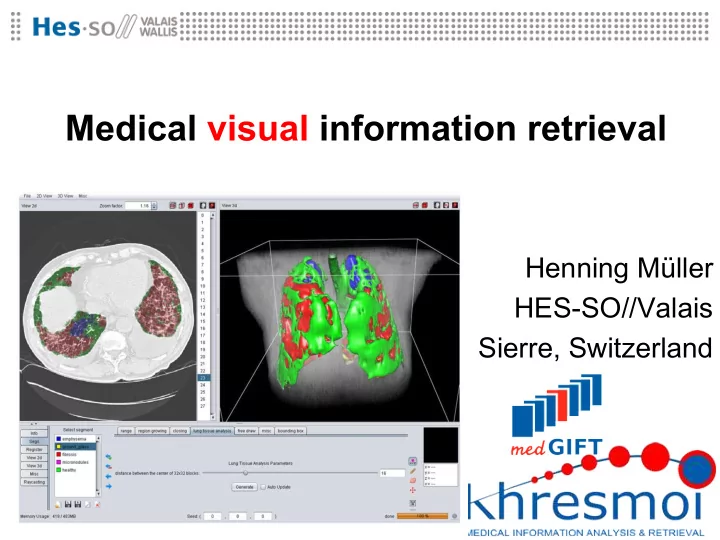

Medical visual information retrieval Henning Müller HES-SO//Valais Sierre, Switzerland
Overview • Motivation for visual retrieval – Differences between text and visual search – A model for CBIR • Main techniques – Context vs. content – Detection vs. retrieval – Semantics vs. free text • Current example systems – Springer images, Goldminer, MedSearch, Yottalook • Upcoming challenges • Conclusions
Motivation • Enormous amounts of images are being produced digitally and are available for analysis – Part of patient records – Part of scientific articles, videos in addition to content • New machines and protocols produce an increasing variety of image types that require explanations • Images are needed and often require visualization – Thin slices, reconstruction in the brain of clinicians • Annotated data can be used to train detection – Data from detection can then also be used for retrieval
Differences text and visual search • Text contains semantic information directly – … mapping on controlled vocabularies may help retrieval • Visual features are fairly low-level – Colors, textures, basic shapes – Automatic segmentation is an ill-posed problem – Visual words can help solving some of the problems – Simple mapping to terminologies can also help • Annotation of images improves retrieval quality – But most often annotations is not of the images but rather puts the images into a specific context
Content-based image retrieval Feature Image feature Feature 1 0.5 extraction Database Feature 2 0.7 ? Feature 15 0.1 Feature 25 0.3 … Relevance feedback Similarity calculation
Content vs. context • Visual features describe global or regional content – Annotation of the content exists only rarely • Clinical records and articles often describe small parts of the content and rather put them in context – Which were the problems? – Why was the image taken? – Age of patient, anamnesis, … • A partial description of the ROI is often available • Figure captions describe also part of the content • Both content and context are complementary
Detection vs. retrieval • Detection – Classification of small anomalies in usually a region of interest (ROI) or globally in the image – Annotated training data is necessary – Interpretation needs to be given, so the system is not a black box • Retrieval – Training data is not necessary, or not available – Search for similarity • For clearly defined concepts or visual data • Can be seen as a classification relevant/non-relevant
Visual words Salient regions Quantization of the feature space All pixes, grid, high gradient • Division of the feature space into Original feature space M groups: visual words • N-dimensional feature vector for • Clustering (k-means) each salient region • Cluster centers are the words Visual words space Bag of Visual Words • Optimal number of words needs • Histogram of words for an image to be found or an image region based of the salient points • For each image a histogram can be created • M-Dimensional feature vector • Analogy to text words
Semantics vs. free text • Free text is also treated before retrieval – Stemming, stop word removal, phonetic retrieval – Translation is possible but sometimes hard – All data are readily available, little treatment • Semantic data – Extracted from text • Probability to be true, relatively high for a few terms in medical texts – Synonyms, hypernyms, hyponyms can then be used – Existing ontologies are available (LinkedLifeData) – Understanding what particular parts are about
Goldminer.arrs.org (249,000 images)
www.springerimages.com (3.3 mio images)
medgift.hevs.ch/demos/ (231,000 images)
www.yottalook.com (70,000 images)
Upcoming challenges • Develop simple interfaces for many types of browsing and limiting the results set – Faceted browsing, interactive changes, propositions – Also on small screens for mobile devices – Include 3D and 4D data • Linking visual retrieval/detection with semantic data – Better understanding visual data and its context – Filtering out unwanted information • Finding small ROIs for an in depth analysis • Treating extremely large databases • Quickly changing modalities (limited training data)
Regions of interest are often small
Conclusions • Images are still not fully integrated into retrieval – Not only in the medical field – Mobile devices and detection techniques change this – Visual data is analyzed much faster than text • Regions of interest are often very small – Context is needed to find and analyze them – Interactivity can help as well • Many new tools are becoming available – LinkedLife data and semantics are required for images – Many publishers are now making also images available as these are valuable
Questions • ? http://www.khresmoi.eu/ http://medgift.hevs.ch/
Recommend
More recommend